Issue #119: Pasta al Pesto
Beans on the Brain and on the Plate, Ligurian Memories, Food Often Really Is Better Tasting in Italy, A Recipe for Pesto
Over the past few weeks I’ve been working with my colleagues Alison Tozzi Liu and Lauren McGrath to help bring to NYC’s restaurant community a global campaign to double the consumption of beans by 2028. Called Beans is How, the campaign aims to increase bean consumption in an effort to fight climate change, hunger, malnutrition, the cost of living crisis, and other global issues. Tiny and mighty, beans are an affordable, delicious, nutrient-dense food, the production of which helps regenerate soil and provides many other benefits. Beginning Monday, September 18, Climate Week, and running through the end of October, the Beans is How Menu Challenge NYC, invites chefs and restaurants, street vendors, and other food service providers in the NYC area to highlight bean dishes on their menus (see list). Please go out and order them, eat them, photograph, and post about them on social media. Let’s show the world we care about the future of our people and our planet and that we have the power to do something about it, deliciously. Beans is how.
I have been to the Italian coastal region of Liguria a half-dozen times, and each time the same three things always amaze me: the physical beauty of the place, how overrun so much of the coast is with tourists, especially Cinque Terre, and the food.
Oh, the food. I dream of the blankets of thin, crisp focaccia that emerge in the mornings from the ovens in the bakeries in La Spezzia, warm, salty, oily. I love the selection of Mediterranean fish you get at even the humblest restaurants, cooked simply with olive oil and salt. And the pesto. That pesto.
The first time I ordered trofie al pesto—trofie are the local, hand-made pasta squiggles that are rolled off the palm—it was both a surprise and a revelation. The surprise was the potatoes and green beans that were mixed in with the noodles. The revelation was the rich, creamy texture and subtle flavor of the sauce.
Pesto was trendy in Toronto in the 1980s, where I lived before my first visit to Italy in 1992. Pungent with garlic and the powerful, near-licorice flavor of basil, it was usually more like an oily dressing than an elegant sauce. Torontonians were putting pesto on everything, sandwiches, pizzas, salads, you name it.
My first pesto in Liguria was totally different. We were in a restaurant in Imperia. The noodles were soft, delicate. The sauce was rich, without any sharp edges. I cleaned the bowl with bread while the patron of the restaurant played the piano and sang.
That elegant sauce, I would later learn, is the result of a few things. First, the sauce is traditionally made in a mortar and pestle, which almost always produces a finer texture and more subtle flavor than a food processor or blender, no matter what you are making. The pounding doesn’t disturb the cell structure of the ingredients in the same way so they don’t oxidize as they break down and merge.
Second, the pesto isn’t just blended, its emulsified, so the oil is distributed among the other components and held in place by the garlic, pine nuts, and cheese that act as emulsifying agents. Third, the sauce is loosened with some of the pasta cooking water which, because of the potato cooked with the noodles in the same pot, has a high content of starch that helps it cohere. Fourth, Italian pine nuts have quite a different flavor than their shorter, rounder Chinese cousins we have access to most often. Fifth, Ligurian olive oil is particularly delicate with a buttery texture and fruity flavor. Finally, the basil in Liguria is grown in such a way that the leaves are smaller and the flavor is sweeter than the overgrown, sharper basil we often find.
One of the funniest things I ever saw on Italian television, which is full of funny things, was a sort of cooking show/kibbitz of two women making pesto. Just one was actually making the sauce, explaining to her friend how to do it the Ligurian way in a marble mortar with a large wooden pestle. (As an aside, I was proud to possess the same mortar and pestle she was using, a birthday gift Nate once secretly secured for me from a tiny shop in Monterosso. It arrived in a shoebox protected with wads of paper towel.)
The pesto maker began by pounding garlic with salt to a smooth paste. She added some pine nuts and kept pounding. Than some basil. And some cheese. Some more pine nuts, a splash of olive oil to start the emulsion. I watched for an hour as she pounded more basil, dribbled more oil, chatted with her friend, all the while swirling the pestle to build the emulsion so the addition of even more oil wouldn’t break it. An hour into it, the cameras still rolling in real time, she still wasn’t done. But she stopped to put the pasta water on to boil.
So many things to enjoy about this episode, not the least of which is that there were no cutaways or other edits to make this look any easier or less time consuming that it actually was. They chatted. She pounded. They chatted some more. Once the pasta was cooked, along with some potatoes and beans, she transferred the pesto from the mortar to a large bowl. She added some some more grated Parmigiano and stirred in some hot cooking water from the pot to make a rich sauce. In she dumped the noodles, potatoes and beans, tossing with the sauce, additional olive oil, a pinch of salt, and some more cheese.
I am not going to suggest that you pound your pesto in mortar for an hour. (Though I’ve done it and I think it is worth the effort when you have the time and energy.) Nor will I insist you buy basil and pine nuts imported from Italy. The best Italian chefs always make do with what they’ve got. But I will suggest you use fine extra-virgin olive oil and real Parmigiano-Reggiano, both readily available here, and that you incorporate many of the same techniques to make a delicious Pasta al Pesto at this time of year, when farmers seem to have more basil than they know what to do with.
RECIPE: Mitchell’s Pasta al Pesto
2 or 3 cloves garlic, peeled
Salt
3 tablespoons pine nuts
¼ cup grated Parmigiano-Reggiano, plus more for finishing
1 large or 2 small bunches basil, leaves only
¾ cup best-quality extra-virgin olive oil, plus more for finishing
1 small, starchy potato, peeled
Handful of green beans, trimmed
1 pound short, twisted pasta, such as trofie, casarecce, gemelli, malloreddus, or busiate
In a food processor fitted with a metal chopping blade, add the garlic cloves and a pinch of salt. Pulse to mince the garlic, scraping down the sides once or twice. Add the pine nuts and half the cheese and continue pulsing and scraping down the sides to produce a sort of paste. Add the basil leaves and the remaining cheese and pulse to finely mince the leaves. Scrape down the sides again. With the machine running, slowly pour the oil through the feed tube to produce an emulsion, like a green mayonnaise. Stop about halfway through, scrape down the sides, and continue adding the oil slowly. Set aside.
Bring a large pot of generously salted water to a boil. Cut the peeled potato lengthwise into quarters and then slice about ¼-inch thick. Cut the beans on a diagonal so they are abou the same length as your pasta. Once the water boils, add the pasta, and stir so it doesn’t stick. After about 3 minutes, add the sliced potato to the same pot, stirring again. After another 3 minutes or so, add the beans. Continue cooking until the pasta just reaches al dente.
Meanwhile, transfer the pesto from the food processor to a large mixing bowl. Be sure to scrape out every last delicious bit of the sauce with a rubber spatula. With a ladle, add about 1/3 cup of hot water to the bowl with the sauce, stirring with that rubber spatula to incorporate it and melt the cheese. It should appear creamy. If not, add a little more. Add a pinch of salt.
When the pasta is cooked, the beans and potatoes will also be done. (You want your green beans a little overcooked by American gastronomic standards.) Reserve a small cup of the cooking water, just in case, and dump the pot in a colander in the sink to drain. Do not rinse. Add the drained pasta with the potatoes and beans to the bowl with the pesto and start tossing them in the sauce. Add a dash or two of additional olive oil and a couple of spoons of grated cheese along with another splash of hot cooking water and keep tossing until the noodles are coated. Transfer to serving bowls and enjoy immediately. Pasta waits for no one.
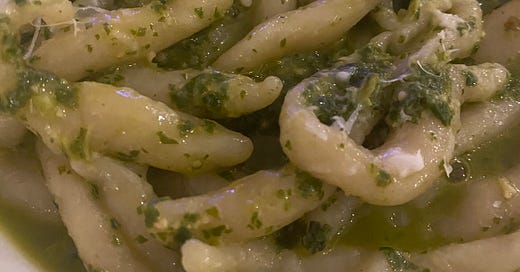



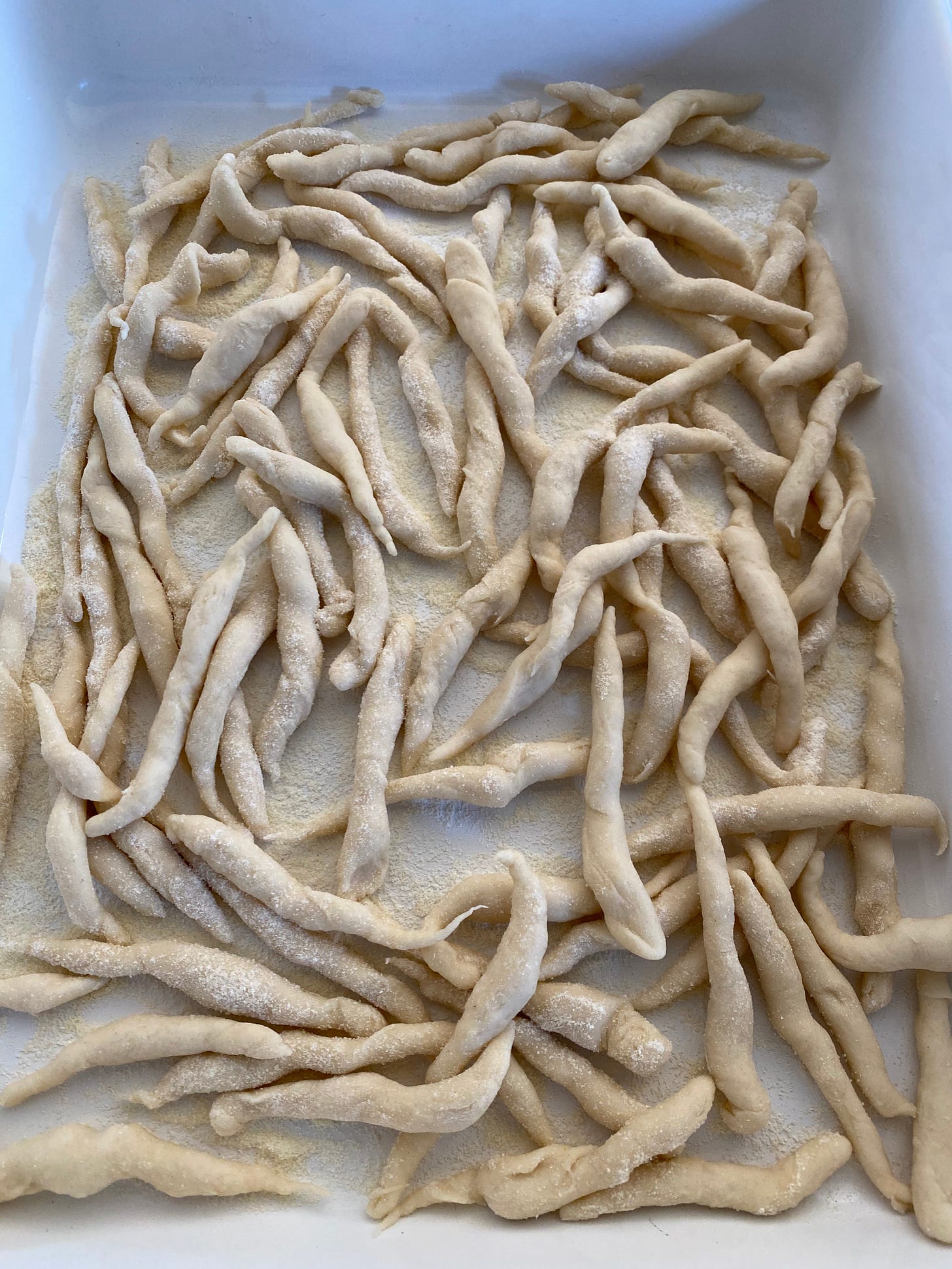

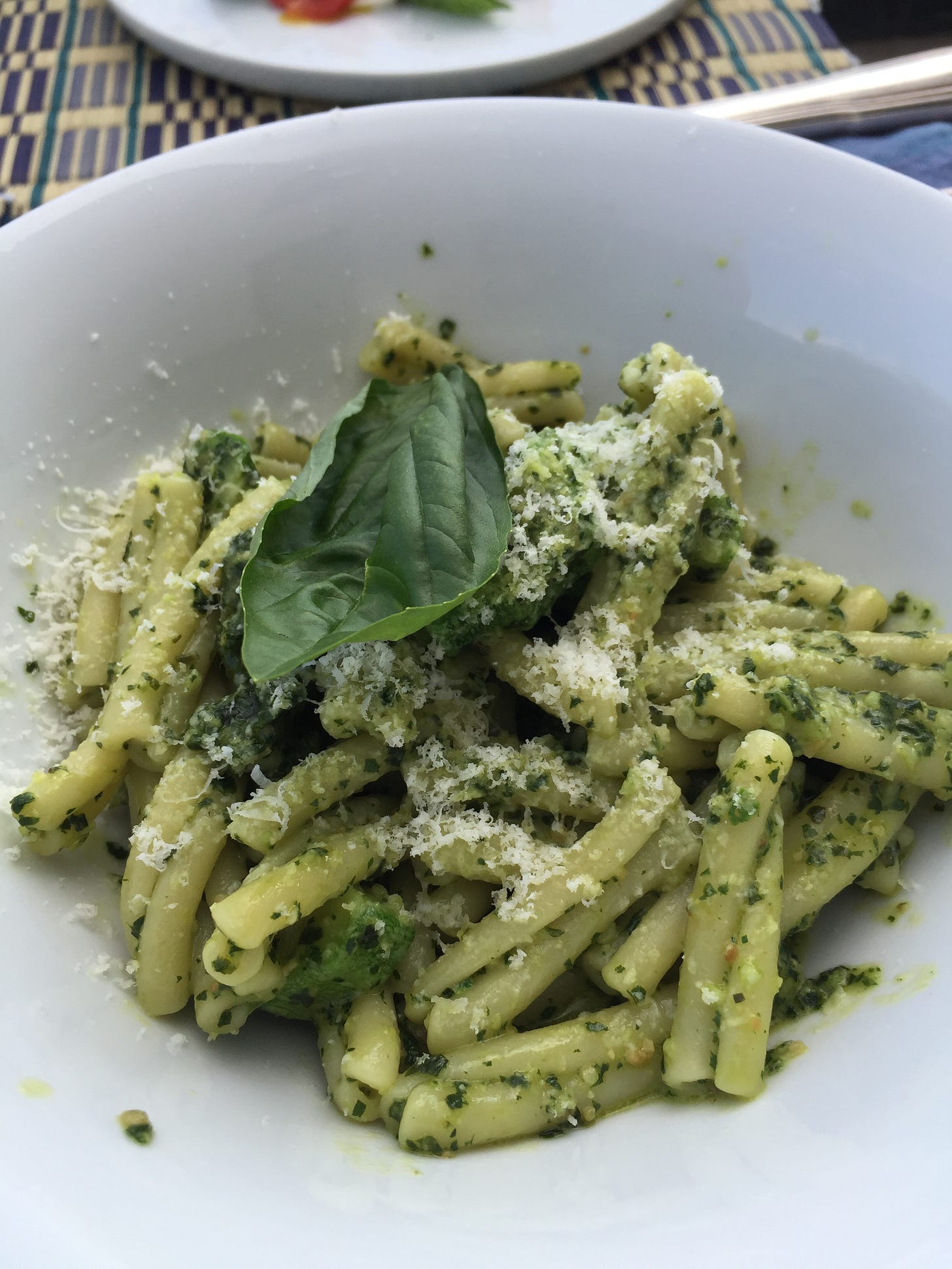
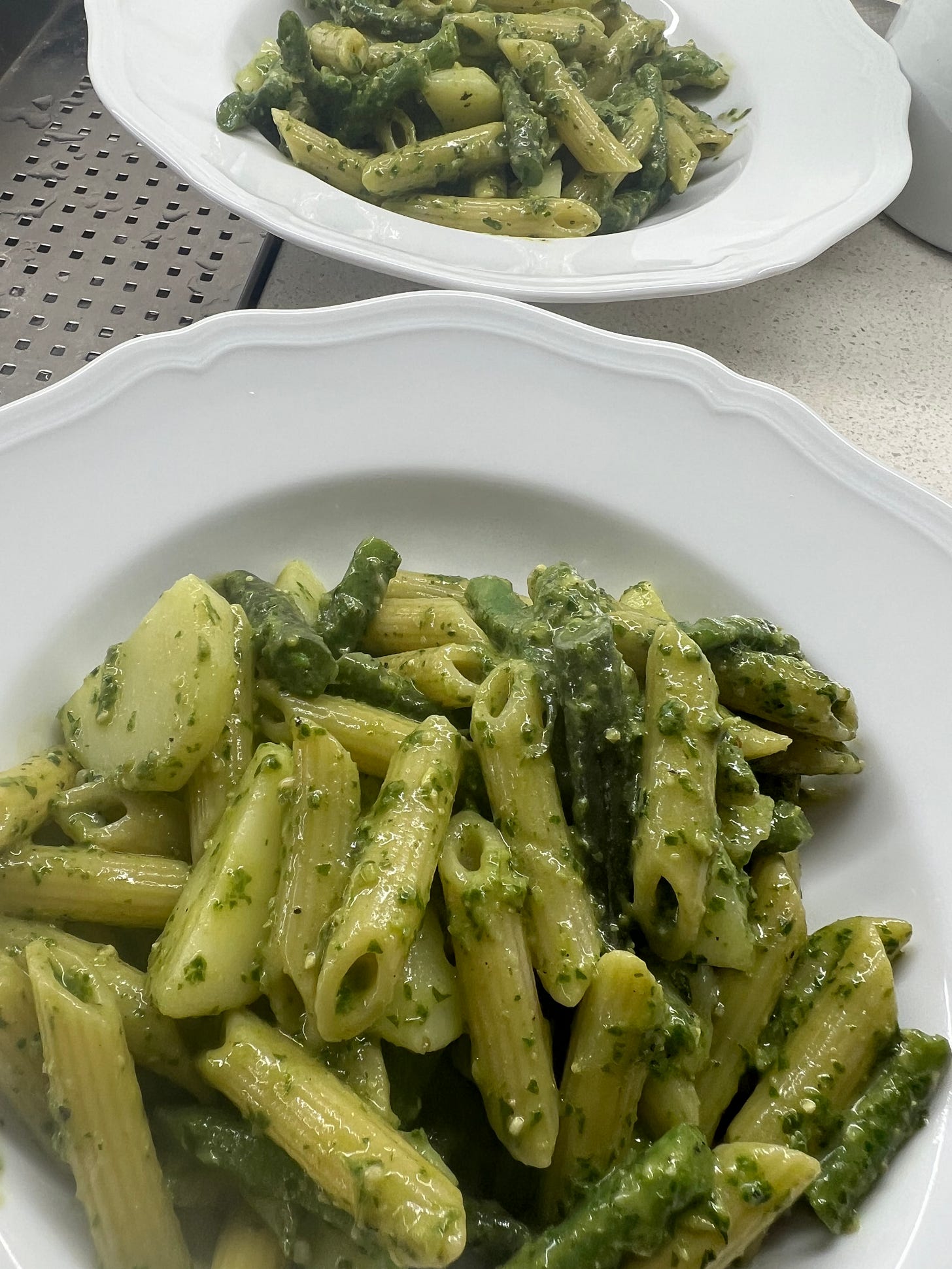
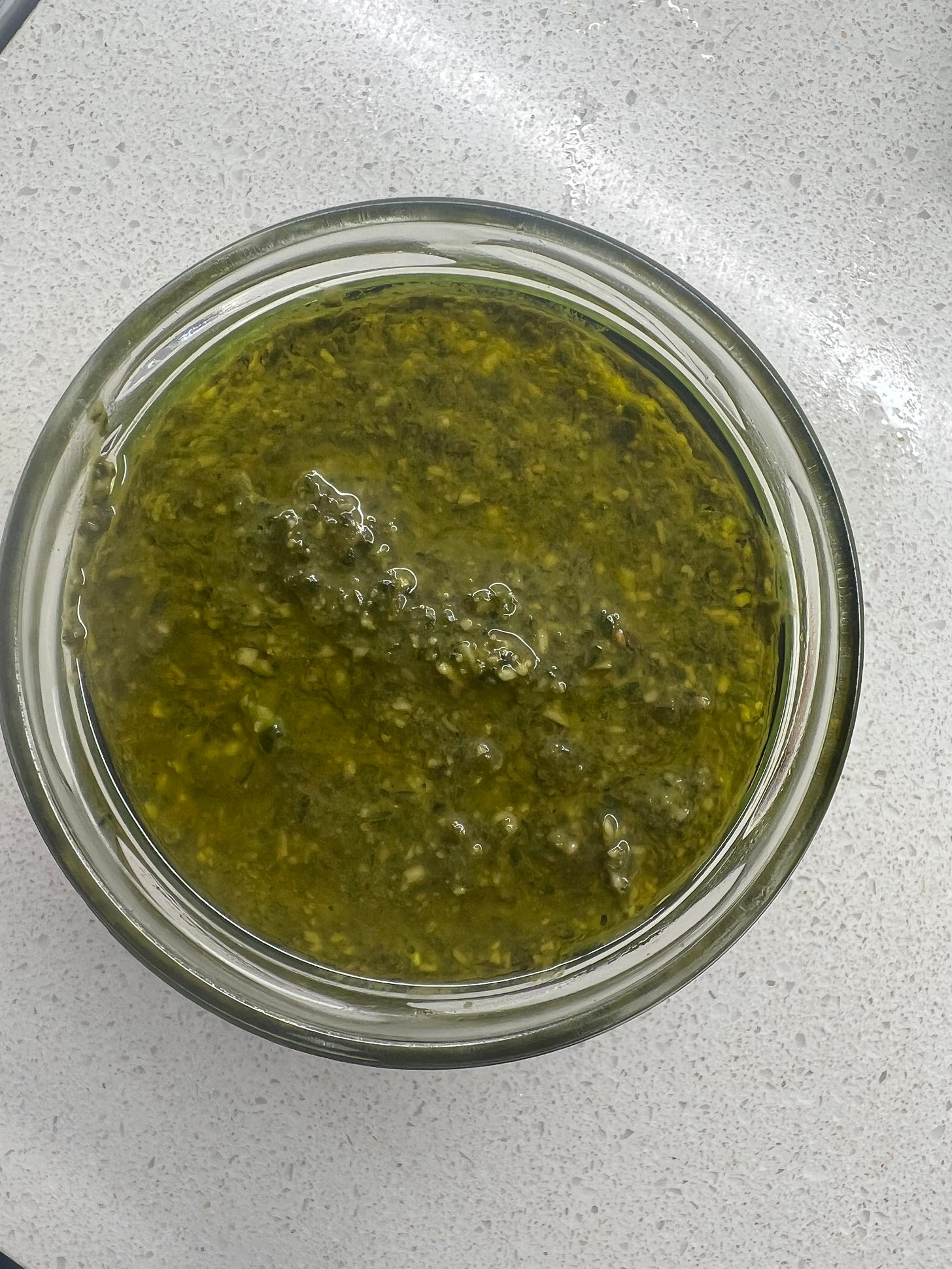
Oh, Mitchell! You always bring back such memories. I finally learned how to make pesto from Meli Solari, wife of Chef Francesco Solari, at the restaurant Ca' Peo in the village of Leivi up above Rapallo. What she taught me was not to pound the basil but instead to sort of stroke it, down with a semi circular counter-clockwise motion, as you turn the mortar after every second or third strike. What came out was so velvety it was almost gelatinous--unctuous for sure and enveloping of every strand of pasta, every thread of bean, every tiny glob of potato. It's a magnificent dish and, somewhat like a good cappuccino, seldom done right in our country. Thank you for this!